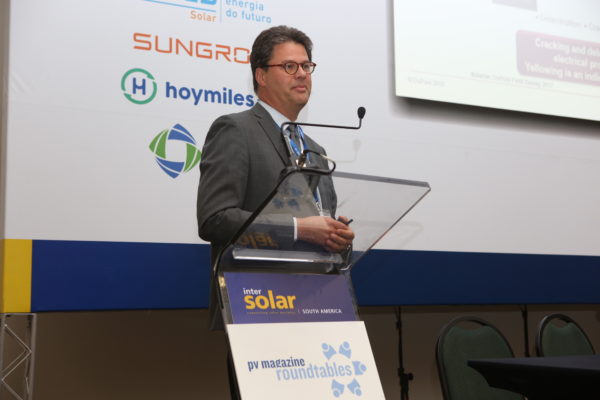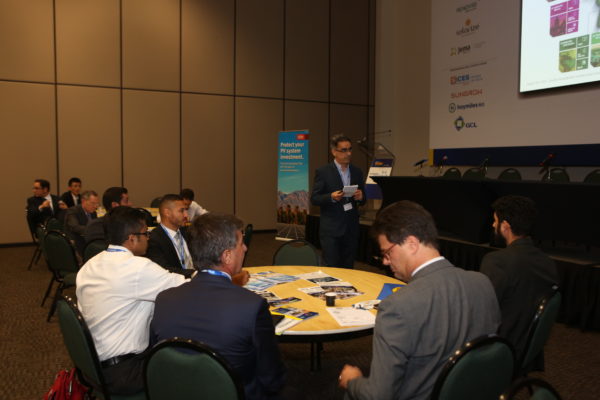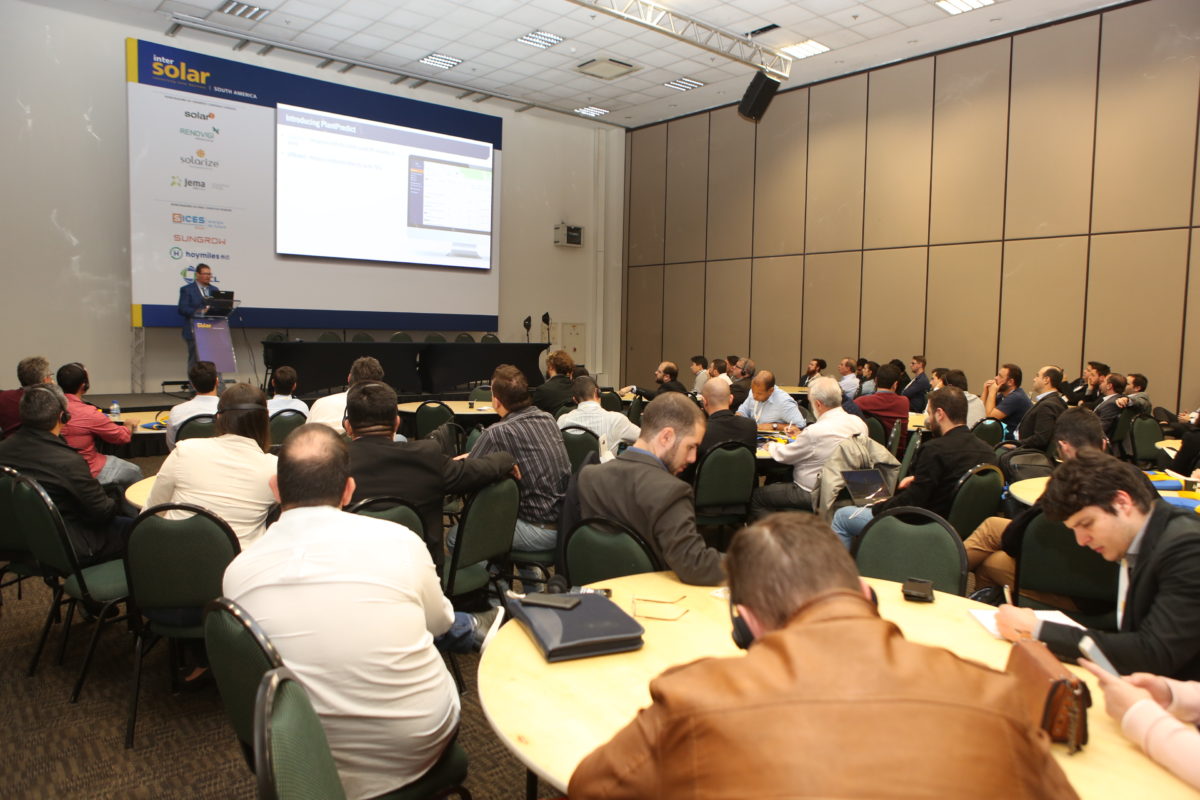The pv magazine Quality Roundtable, which focused on risk concerns and solutions for solar suppliers and operators in Latin America, included speakers from DuPont Photovoltaic Solutions – the solar unit of U.S. chemical group DuPont; Chinese module maker JinkoSolar; German cable and connector provider Staubli; Brazilian PV system provider Sices Brasil; Chinese inverter maker GoodWe; and the Photovoltaic Systems Laboratory of the University of Sao Paulo.

Although heterogeneous in composition, the group of experts – together with a discussion panel featuring other industry professionals – shed light on key quality issues in Latin America and discussed future prospects.
Latin American solar markets are, like all other established PV markets, not immune to quality issues such as module degradation caused by Potential Induced Degradation (PID) or Light-Induced Degradation (LID), or failures in panel backsheets.
The roundtable also highlighted how the quality of PV projects and their components, both in the rooftop and large-scale segments, may also be put at risk by faults during the installation process – with cable or connector problems – and reduced performance by inverters.
Backsheets matter
Stephan Padlewski, Market & Program Leader for DuPont Photovoltaic Solutions in the EMEA region, outlined how problems coming from chemical and mechanical backsheet degradation may represent a challenge for large-scale projects in Latin America. He presented survey data from 190 solar facilities totaling 450 MW across North America, Europe, and Asia Pacific, and data on modules provided by 45 manufacturers.
The survey showed in particular that 22% of the modules installed at these facilities were affected by performance issues, and that backsheets are the most affected components.
“Selecting the most UV and thermally-resistant backsheet materials is key if panels are expected to operate in harsh environments,” he said. Mr. Padlewski also stressed how in hot and arid climates the number of defects is considerably higher.
Thinking in terms of $/kWh instead of $/W, according to the speaker, is one recommended way to maximize returns on investment. More importantly, Mr. Padlewski said, is to take into account that IEC certification alone is not designed to predict the long-term performance of panels.

© Solar Promotion International GmbH
Light-induced degradation in mono PERC cells
Alberto Cuter, General Manager of Jinko Solar in Latin America, discussed how LID may negatively affect the levelized cost of electricity (LCOE) of large-scale solar, and also pointed out how risks from this kind of issue can be mitigated.
Jinko has recently decided to move from p-type to n-type wafers in mono cell production. This, according to Cuter, could almost eliminate LID, as the silicon material used in n-type wafers is free of boron and oxygen.
Although n-type technology has a limited market share thus far, it is expected to increase considerably over the next year, in part due to its ability to almost eliminate LID.

Early degradation of modules in Brazil
Gilberto Figueiredo, from the Laboratory of Photovoltaic Systems at the University of Sao Paulo’s Institute of Energy and Environment, presented results from a case study showing early degradation of PV modules in the field. A 0.52 MW generator used n-type monocrystalline silicon modules, put into operation in 2014.
Popular content
Figueiredo discussed how homogeneous degradation within the array began after two years of continuous operation, and how PID was one of the factors responsible for module degradation.
Panel discussion: How to mitigate the risks associated with module faults
A panel of Thiego Bello, Solar Area PE for Brazil and Uruguay with Enel Green Power Brazil; Vitor Rodrigues, Business Stream Coordinator for TÜV Rheinland Spain and Regional Field Manager for Solar South America; Kaushik Roy Choudhury, from DuPont Photovoltaic Solutions; and Mauro Carmello, managing director of the CESI Do Brasil Consultoria, discussed the issues which concern developers of large-scale PV projects across the range of climates in Latin America.
Using higher quality materials and products was seen as a key solution to most problems, although it was also stated no project in Latin America should be considered immune to faults.
Potential problems with cables and connectors
Julian Rau, responsible for the global sales of PV for the Switzerland-based Stäubli, discussed the impact of improper cabling and connector installation.
He listed the top 20 problems and their financial impacts while also showing how such failures fall into three broad categories: quality of components; improper cross-connections of connectors from different suppliers; and defective installations.
“The obvious lesson is, don’t try to save money with low-end products,” Mr. Rau said. “And people need to read the instructions for installation before installing, not after. This is often the cause of mistakes.”
Installation issues
Brazil’s largest PV system provider, Sices Brasil, highlighted key problem areas for Brazil’s distributed generation market, which includes all solar projects – rooftop and ground-mounted – not exceeding 5 MW in size.
He said the most common problems during installation are: outbreak in the grid or in the PV array; saturation of the utility transformer; excessive harmonic distortion on the grid; single-phase imbalance; sporadic saturation of inverter IGBTs; and increase of voltage during the injection of current into the network.
He also pointed out another series of problems that comprised insulation failures; bad contacts in the PV system; incorrect connection of AC cables to inverter terminals; strings in parallel with different orientations; and connection of PV arrays to inverters with wrong polarity.
Critical points for high-quality inverters
Finally, Chinese inverter maker Goodwe presented the basic eight tests for inverters in the PV industry. Lucas Lu, Overseas Head of Solar Academy at Goodwee, explained the company’s inverters are tested using AC and DC power sources, to simulate different weather conditions and climates and to test MPPT efficiency and output. Mr Lu also showed how string level monitoring can be helpful for troubleshooting.
Multi-MPP tracking was further highlighted as a tool that contributes to higher yields. Goodwee claims its devices have an average efficiency of 98.8%, which compares to an average of 98.3% for inverters manufactured in Europe.
Watch out for future pv magazine Roundtables in India, Taiwan and the United States.
This content is protected by copyright and may not be reused. If you want to cooperate with us and would like to reuse some of our content, please contact: editors@pv-magazine.com.


By submitting this form you agree to pv magazine using your data for the purposes of publishing your comment.
Your personal data will only be disclosed or otherwise transmitted to third parties for the purposes of spam filtering or if this is necessary for technical maintenance of the website. Any other transfer to third parties will not take place unless this is justified on the basis of applicable data protection regulations or if pv magazine is legally obliged to do so.
You may revoke this consent at any time with effect for the future, in which case your personal data will be deleted immediately. Otherwise, your data will be deleted if pv magazine has processed your request or the purpose of data storage is fulfilled.
Further information on data privacy can be found in our Data Protection Policy.